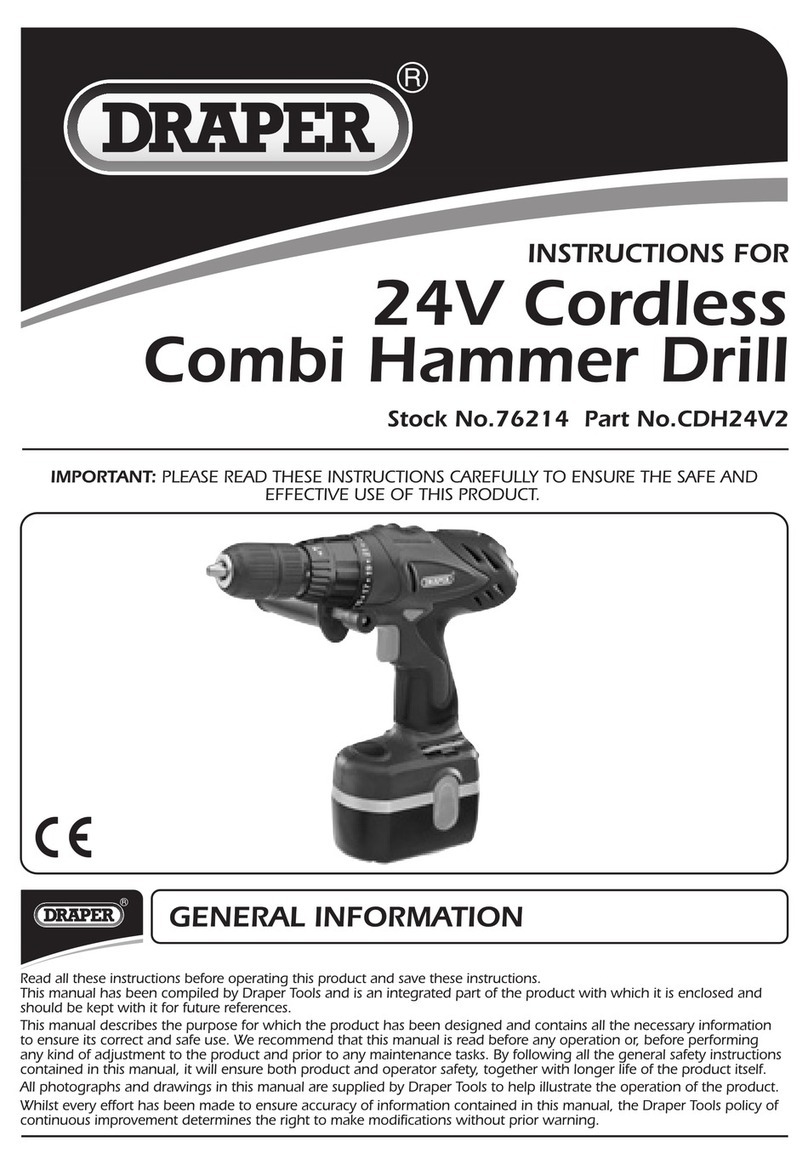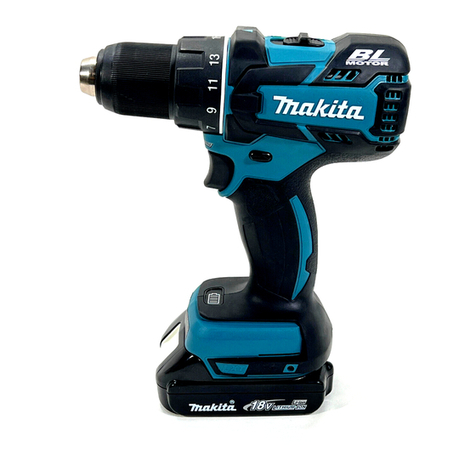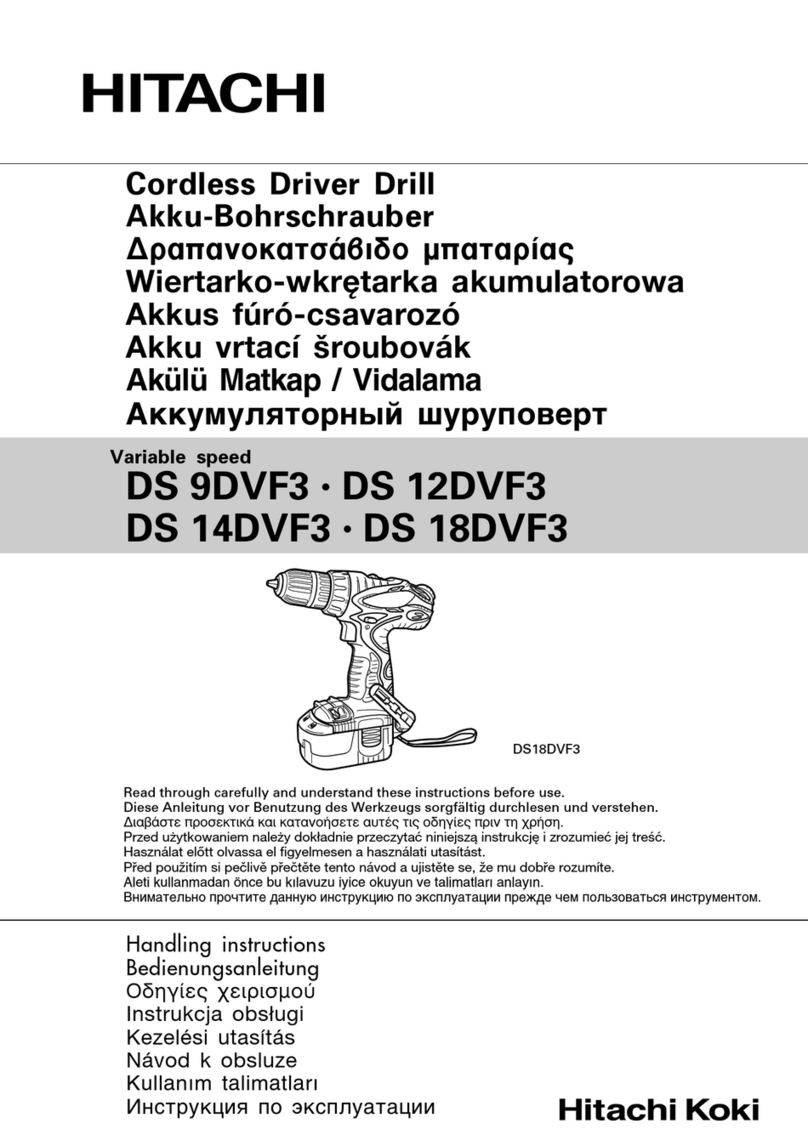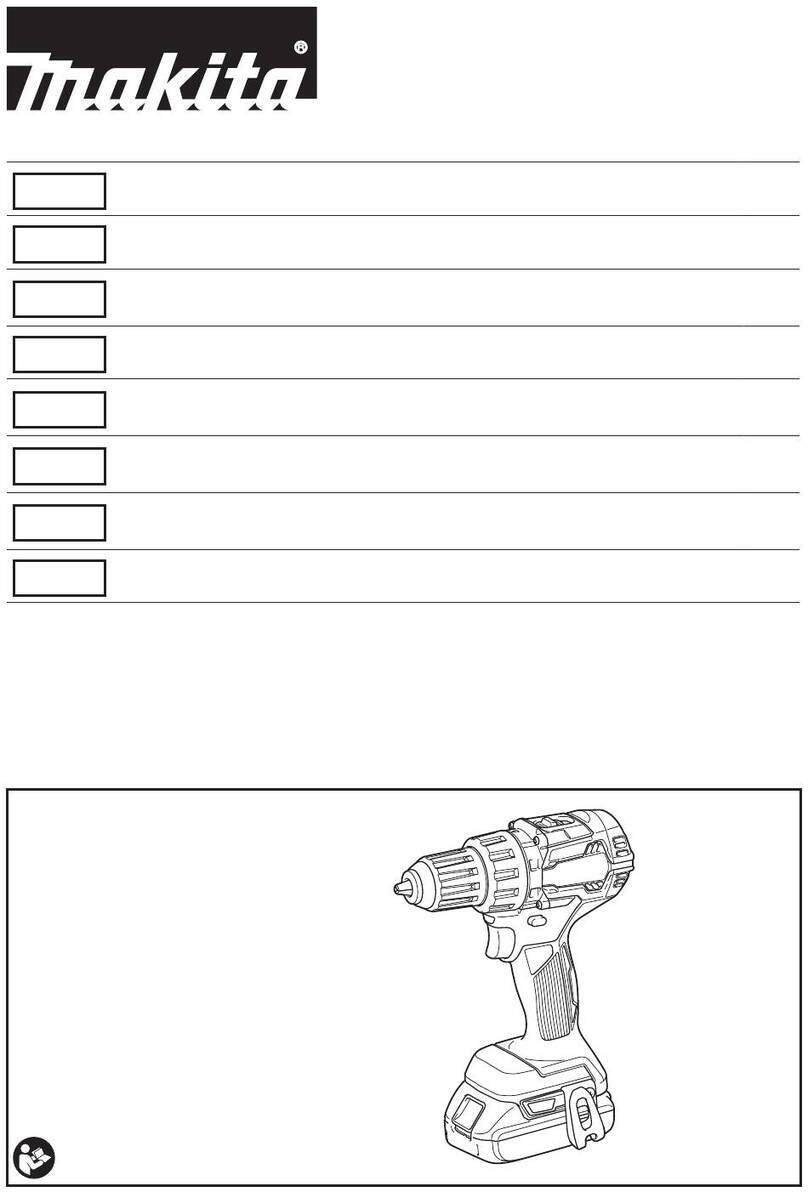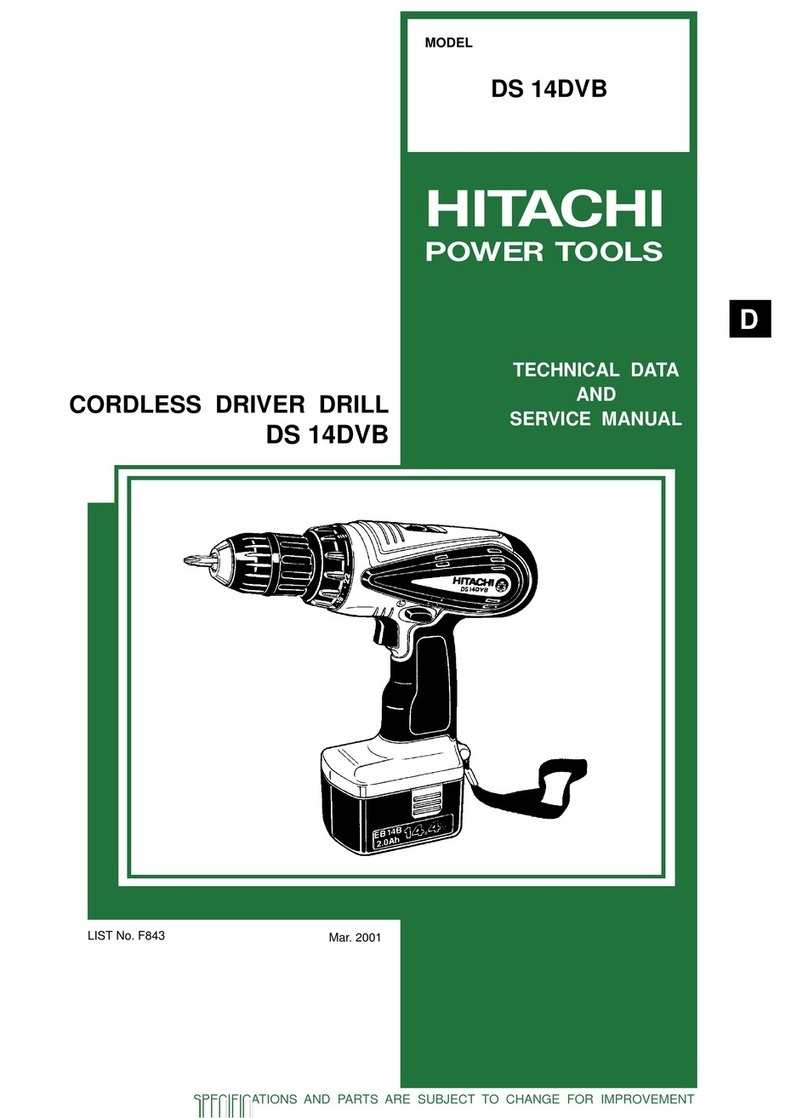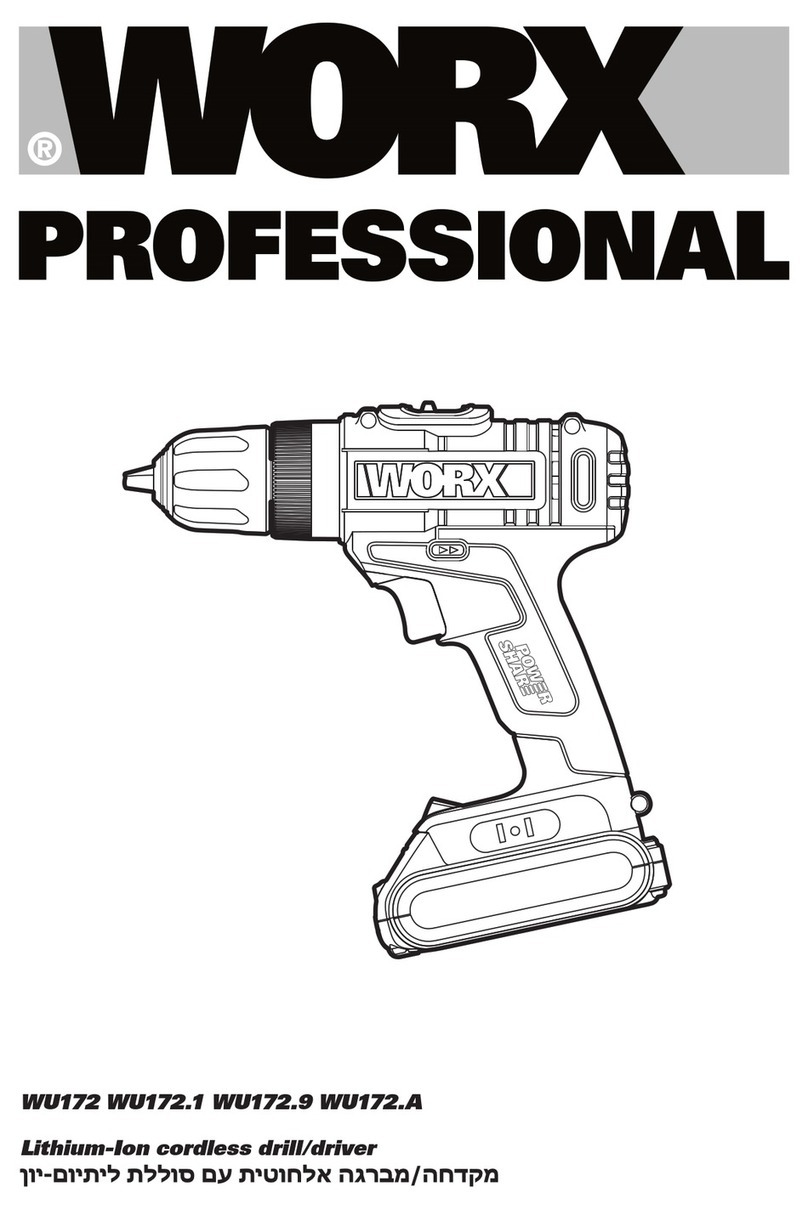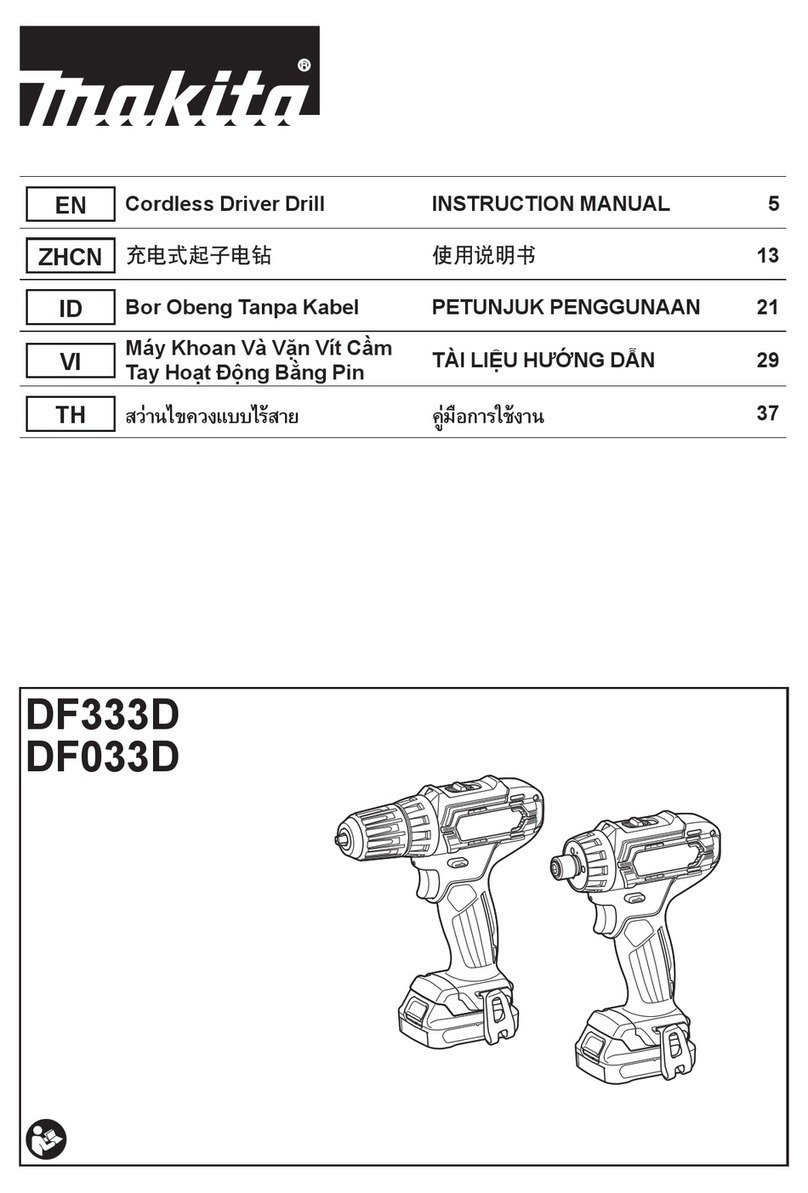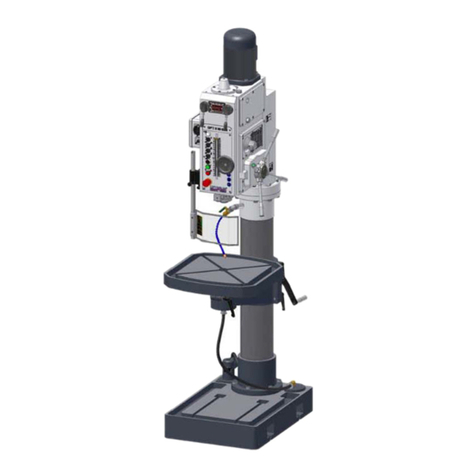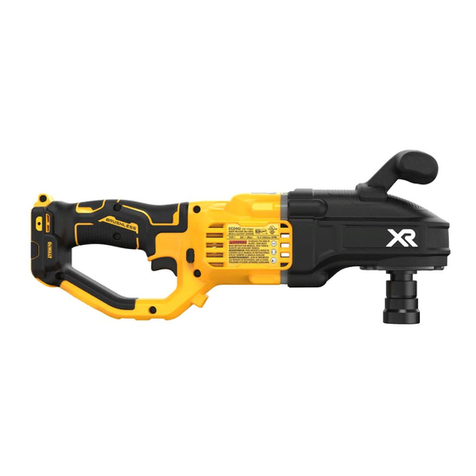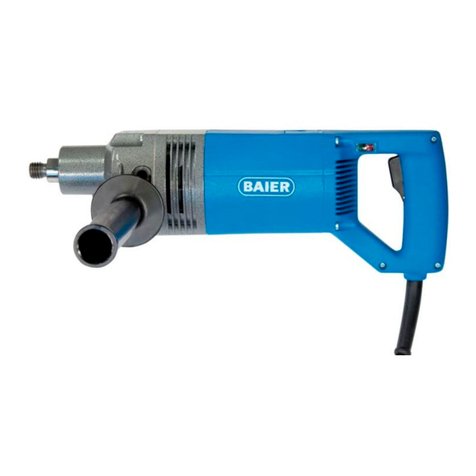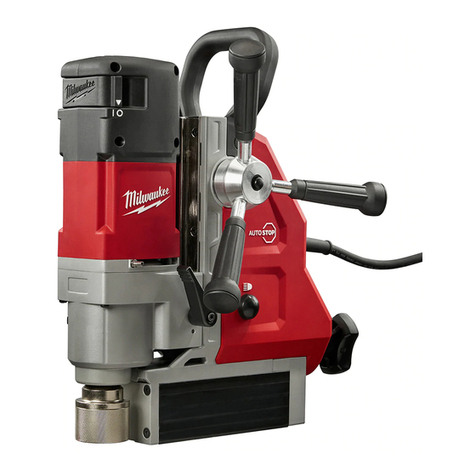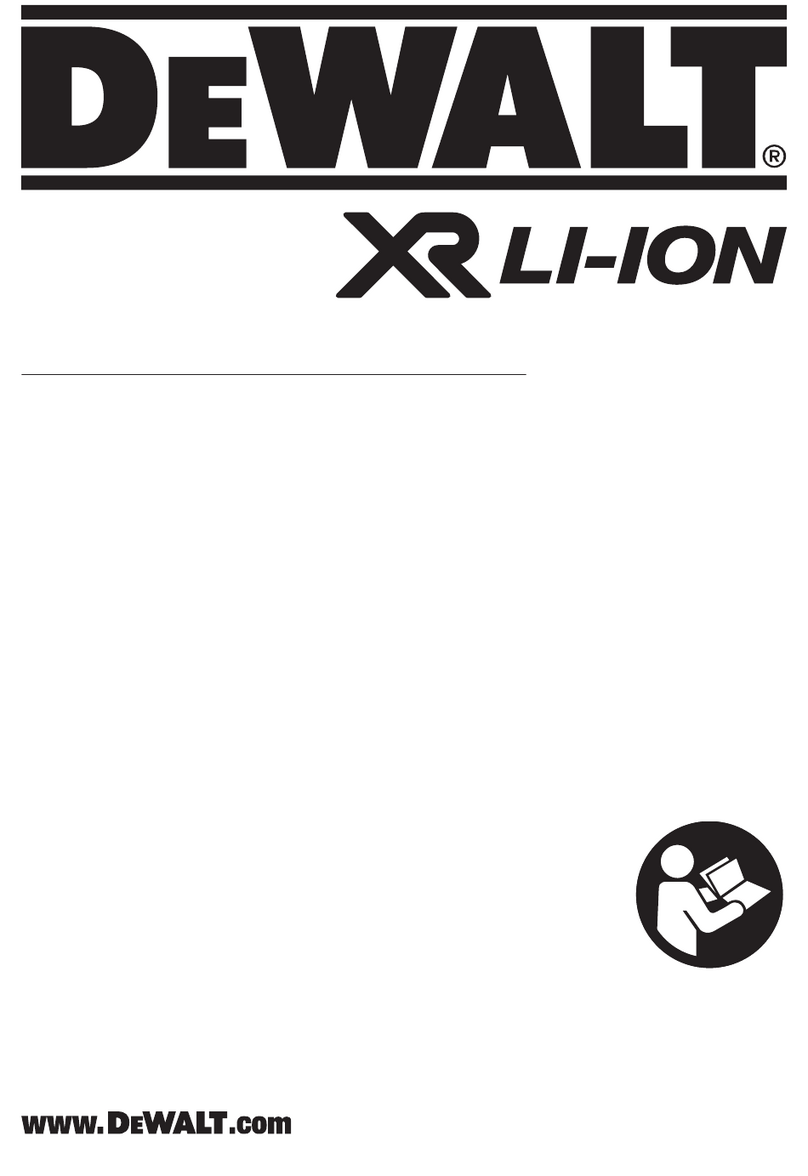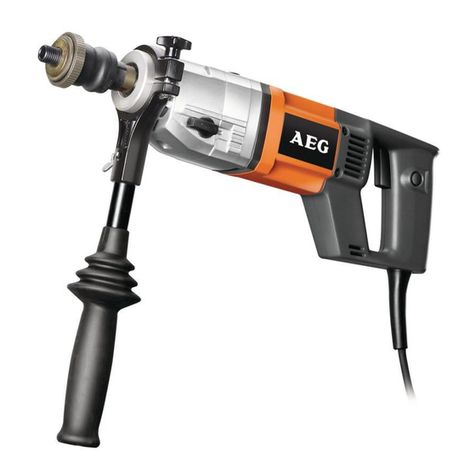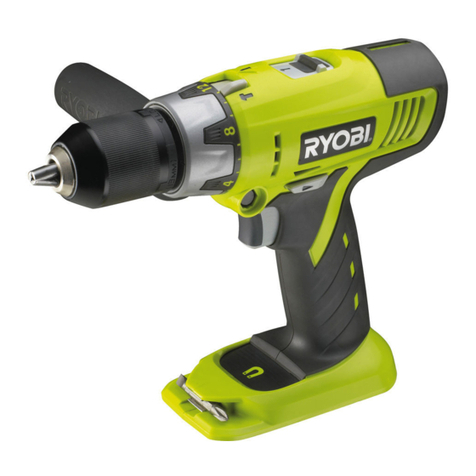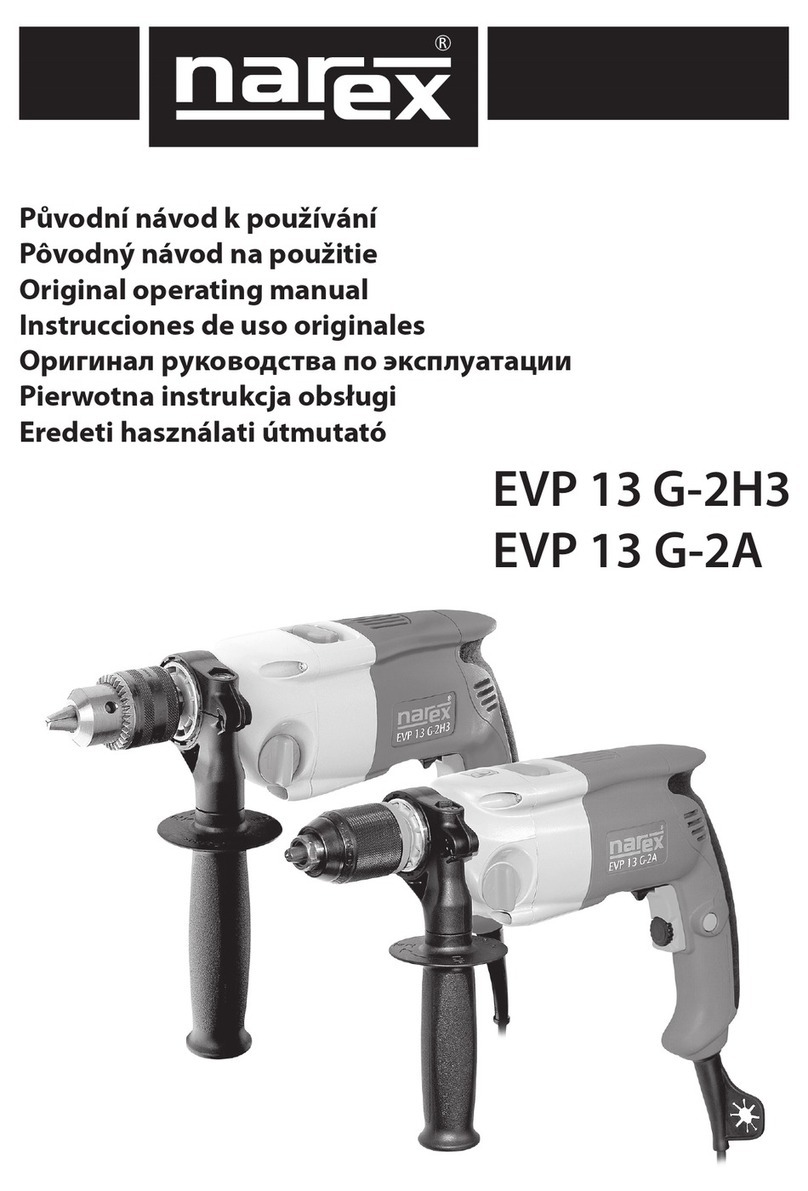DCA Z1J-FF03-13 User manual

Edition 1 Mar., 2012
Read through carefully and understand these instructions
before use.

GENERAL POWER TOOL SAFETY WARNINGS
(For All Power Tools)
WARNING! Read and understand all instructions.
Failure to follow all instructions listed below may result in electric
shock, fire and/or serious personal injury.
Save all warnings and instructions for future reference.
The term “power tool”in the warnings refers to your mains-operated (corded)
power tool or battery-operated (cordless) power tool.
Work Area Safety
1. Keep work area clean and well lit. Cluttered or dark areas invite accidents.
2. Do not operate power tools in explosive atmospheres, such as in the
presence of flammable liquids, gases, or dust. Power tools create sparks
which may ignite the dust or fumes.
3. Keep children and bystanders away while operating a power tool.
Distractions can cause you to lose control.
Electrical Safety
4. Power tool plugs must match the outlet. Never modify the plug in
anyway. Do not use any adapter plugs with earthed (grounded) power
tools. Unmodified plugs and matching outlets will reduce risk of electric shock.
5. Avoid body contact with earthed or grounded surfaces, such as pipes,
radiators, ranges and refrigerators. There is an increased risk o electric
shock if your body is earthed or grounded.
6. Do not expose power tools to rain or wet conditions. Water entering a
power tool will increase the risk of electric shock.
7. Do not abuse the cord. Never use the cord for carrying, pulling or
unplugging the power tool. Keep cord away from heat, oil, sharp edges
or moving parts. Damaged or entangled cords increase the risk of electric
shock.
8. When operating a power tool outdoors, use an extension cord suitable for
outdoor use. Use of a cord suitable for outdoor use reduces the risk of electric
shock.
9. If operating a power in a damp location is unavoidable, use a residual current
device (RCD) protected supply. Use of an RCD reduces the risk of electric shock.
NOTE: The term “residual current device (RCD)” may be replaced by the term
“ground fault circuit interrupter (GFCI)” or “earth leakage circuit breaker (ELCB)”.
Personal Safety
10.Stay alert, watch what you are doing and use common sense when operating
a power tool. Do not use a power tool while you are tired or under the
influence of drugs, alcohol, or medication. A moment of inattention while
operating power tools may result in serious personal injury.
11.Use personal protective equipment. Always wear eye protection. Protective
equipment such as dust mask, non-skid safety shoes, hard hat, or hearing
protection used for appropriate conditions will reduce personal injuries.
12.Prevent unintentional starting. Ensure the switch is in the off-position before
connecting to power source and /or battery pack, picking up or carrying the
tool. Carrying power tools with your finger on the switch or energising power tools
that have the switch on invites accidents.
13.Remove any adjusting key or wrench before turning the tool on. A wrench or a
key left attached to a rotating part of the power tool may result in personal injury.
14.Do not overreach. Keep proper footing and balance at all times. This enables
better control of the power tool in unexpected situations.
15.Dress properly. Do not wear loose clothing or jewellery. Keep your hair,
clothing, and gloves away from moving parts. Loose clothes, jewellery or long
hair can be caught in moving parts.
16.If devices are provided for the connection of dust extraction and collection
facilities, ensure these are connected and properly used. Use of dust
collection can reduce dust-related hazards.
Power Tool Use and Care
17.Do not force the power tool. Use the correct power tool for your
-1- -2-

application. The correct power tool will do the job better and safer at the rate
for which it was designed.
18. Do not use tool if switch does not turn it on or off. Any power tool that
cannot be controlled with the switch is dangerous and must be repaired.
19. Disconnect the plug from the power source and/or the battery pack
from the power tool before making any adjustments, changing
accessories, or storing power tools. Such preventive safety measures
reduce the risk of starting the power tool accidentally.
20. Store idle power tools out of the reach of children and do not allow
persons unfamiliar with the power tool or these instructions to operate
the power tool. Power tools are dangerous in the hands of untrained users.
21. Maintain power tools. Check for misalignment or binding of moving
parts, breakage of parts and any other condition that may affect the
power tool’s operation. If damaged, have the power tool repaired before
use. Many accidents are caused by poorly maintained power tools.
22. Keep cutting tools sharp and clean. Properly maintained cutting tools with
sharp cutting edges are less likely to bind and are easier to control.
23. Use the power tool, accessories and tool bits etc. in accordance with
these instructions, taking into account the working conditions and the
work to be performed. Use of the power tool for operations different from
those intended could result in a hazardous situation.
Service
24. Have your power tool serviced by a qualified repair person using only
identical replacement parts. This will ensure that the safety of the power
tool is maintained.
VOLTAGE WARNING:
Before connecting the machine to a power source (receptacle, outlet, etc.), be
sure the voltage supplied is the same as that specified on the nameplate of the
machine. A power source with voltage greater than that specified for the machine
can result in SERIOUS INJURY to the user, as well as damage to the machine. If
in doubt, DO NOT PLUG IN THE MACHINE. Using a power source with voltage
less than nameplate rating is harmful to the motor.
SPECIFICATIONS
Rated Power Input
500 W
No-Load Speed
0-1200 r/min
Blows
0-15600 …/min
Max. Drilling Capacity
Steel
13 mm
Wood
20 mm
Net Weight
2.5 Kg
※Due to the continuing program of research and development, the specifications
herein are subject to change without prior notice.
ADDITIONAL SAFETY RULES
1. Hold power tool by insulated gripping surfaces, when performing an
operation where the cutting accessory may contact hidden wiring or its own
cord.
2. Wear ear protectors when impact drilling.
3. Use auxiliary handle(s), if supplied with the tool.
4. Always be sure you have a firm footing.
5. Ensure that the drill is firmly chucked before drilling.
6. Keep hands away from rotating parts.
7. Before drilling into walls, ceilings or floors, ensure that there are no
concealed power cables inside.
8. Do not leave the tool running. Operate the tool only when hand-held.
9. Do not touch the bit or the workpiece immediately after operation; they may
be extremely hot and could burn your skin.
10.Some material contains chemicals which may be toxic. Take caution to prevent
dust inhalation and skin contact. Follow material supplier safety data.
SAVE THESE INSTRUCTIONS.
WARNING! MISUSE or failure to follow the safety rules stated in this instruction
manual may cause serious personal injury.
-3- -4-

INSTRUCTIONS FOR OPERATION
Installing or Removing Drill Bit
CAUTION:
Always be sure that the tool is switched
off and unplugged before installing or
removing drill bit.
To install the drill bit, loosen the drill
chuck and insert the drill bit in the chuck
as far as it will go. Tighten the chuck by
hand. Place the chuck key in each of the
three holes and tighten clockwise. Be
sure to tighten all three chuck holes evenly. (Fig. 1)
To remove the drill bit, turn the chuck key counterclockwise in just one hole, then
loosen the chuck by hand.
Switch Action
CAUTION:
Before plugging in the tool, always check
to see that the switch trigger actuates
properly and returns to the “OFF”
position when released.
To start the tool, simply pull the switch
trigger. Release the switch trigger to stop.
For continuous operation, pull the trigger
and then push in the lock button. To stop
the tool from the locked position, pull the trigger fully then release it. (Fig. 2)
A speed adjusting dial is provided so that maximum tool speed can be limited
(variable). Turn the speed adjusting dial in “+”direction for higher speed, and in “-”
direction for lower speed.
Reversing the Rotational Direction
Turn the reversing bar to “F”, the tool will
rotate clockwise, and turn the reversing bar
to “R”, the tool will rotate counterclockwise.
(Fig. 3)
IMPACT to ROTATION Changeover
The impact drill can be switched from
IMPACT (impact plus rotation) to
ROTATION (rotation only) by simply turning
the change ring. (Fig. 4)
When boring metal, wood or plastic
materials, turn the change ring fully
clockwise. The drill rotates as an ordinary
electric drill.
When boring concrete, granite, tile or similar
materials, turn the change ring fully counterclockwise. The drill head impacts against
the material while continuing to rotate.
CAUTION:
Do not use the impact drill in the IMPACT function if the material can be bored by
rotation only. Such action will not only reduce drill efficiency, but may also damage the
drill tip. When changing over, ensure that the change ring is turned as far as it will go.
-5- -6-

Installing Auxiliary Handle
Always use the auxiliary handle ensure
operating safety. Sleeve the auxiliary
handle on the neck of the gear
housing and secure it at the desired
position by rotating the auxiliary handle.
(Fig. 5)
Drilling Operation
When boring metal, wood or plastic materials, turn the change ring fully clockwise
to use rotation only action.
Drilling in wood
When drilling in wood, the best results are obtained with wood drills equipped with
a guide screw. The guide screw makes drilling easier by pulling the bit into the
workpiece. Metal drills may be used when drilling a hole less than ø6mm.
Drilling in metal
To prevent the bit from slipping when starting a hole, make an indentation with a
center-punch and hammer at the point to be drilled. Place the point of the bit in the
indentation and start drilling.
Use a cutting lubricant when drilling metals. The exceptions are iron and brass
which should be drilled dry.
Drilling in concrete, granite, tile or similar materials
When drilling in concrete, granite, tile, etc., turn the change ring fully
counterclockwise to use impact plus rotation action.
Be sure to use a tungsten-carbide tipped bit. Use lower speed when starting,
increase the speed when a hole deeper than 5mm obtained.
WARNING:
Pressing excessively on the tool will not speed up the drilling. In fact, this
excessive pressure will only serve to damage the tip of your bit, decrease the
tool performance and shorten the service life of the tool.
There is a tremendous force exerted on the tool/bit at the time of hole break
through. Hold the tool firmly and exert care when the bit begins to break through
the workpiece.
Always secure small workpieces in a vise or similar hold-down device.
Your arm is subjected to larger reaction force when a thick drill bit is used. Be
careful not to be moved by the reaction force. For this, establish a foothold, hold
the tool firmly by both hands perpendicularly to the material being drilled.
Check and change drill bit regularly. Worn or damaged drill bits may reduce the
drill efficiency, even cause the motor overloaded.
MAINTENANCE AND INSPECTION
CAUTION:
Always be sure that the tool is switched off and unplugged before attempting to
perform inspection or maintenance.
1. Inspecting the mounting screws
Regularly inspect all mounting screws and ensure that they are properly tightened.
Should any of the screws be loose, retighten them immediately. Failure to do so
could result in serious hazard.
2. Maintenance of the motor
The motor unit winding is the very “heart”of the power tool. Exercise due care to
ensure the winding does not become damaged and /or wet with oil or water.
3. Inspecting and replacing the carbon brushes
Remove and check the carbon brushes
regularly. Replace when they wear down
to the limit mark (Fig. 6). Keep the carbon
brushes clean and free to slip in the
holders. Both carbon brushes should be
replaced at the same time. Use only
identical carbon brushes.
-7- -8-

Remove the handle cover by
loosening the screws on it with a
screwdriver, and remove the holder
plate. Pull out the brush holder and
disconnect the wire connecting to
the stator, then remove the worn
out carbon brushes and replace
new ones. Replace the brush
holder and the holder plate, and
then reinstall the handle cover by tightening the screws. (Fig. 7)
CAUTION:
Carefully ascertain that the internal wiring and so on are located at their regular
positions and that there is no possibility of the rotary part (armature) being
contacted by the internal wiring or other items.
Be careful not let the internal wiring be caught in it to avoid the risk of electric
shock when reinstalling the handle cover.
※To maintain product SAFETYand RELIABILITY, repairs, any other maintenance
or adjustment should be performed by authorized service centers, always using
original replacement parts.
if the supply cord of this power tool is damaged, it must be replaced by a specially
prepared cord available through the service organization.
Service center:
ZHENGDA TOOLS [M] SDN BHD
No. 18-22, Jalan Haji Abdullah Sg.Abong , 84000 Muar , Johor. W. Malaysia
-9- -10-

EXPLANATION OF GENERAL VIEW
1
ChuckKey
25
Cross Recessed Countersunk
Head Screw M4×10
2
Drill Chuck
26
Armature Assembly
3
Spindle
27
Baffle Plate
4
Circlip for Hole
28
Cross Recessed Pan Head
Tapping Screw ST4.2×55
5
Dust Seal
29
Stator Assembly
6
Ball Bearing 6002DU
30
Ball Bearing 608ZZ
7
Ratchet 2
31
Rubber Pin
8
Ratchet 1
32
Motor Housing
9
Change Ring
33
Nameplate
10
O Ring
34
Auxiliary Handle
11
Washer
35
Stopper
12
Cross Recessed Pan Head
Tapping Screw ST4.8×35
36
Cross Recessed Pan Head
Tapping Screw ST4.2×20
13
Gear Housing
37
Handle Cover
14
Driven Gear Spindle
38
Cross Recessed Pan Head
Tapping Screw ST4.2×16
15
Circlip for Shaft
39
Holder Plate
16
Driving Gear
40
Brush Holder
17
Ball Bearing 608ZZ
41
Carbon Brush
18
Driven Gear Complete
42
Trigger Switch
19
Spring
43
Capacitor
20
Washer
44
Inductance
21
Needle Bearing HK0910
45
Cross Recessed Pan Head
Tapping Screw ST4.2×16
22
Gear Housing Cover
46
Strain Relief
23
Ball Bearing 608ZZ
47
Cord
24
Bearing Holder
48
Cord Guard
-11-
Table of contents
